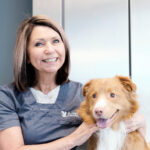What is HD X-ray for dogs?
You may have heard of hip dysplasia, but what exactly is it? And how do you know if your dog needs an HD X-ray? HD X-ray for dogs is a gentle and precise X-ray examination that focuses specifically on the dog's hips. This method is a standard procedure for assessing the degree of hip dysplasia and can help veterinarians develop a treatment plan to improve the dog's quality of life. Under one HD X-ray for dogs the animal will be placed in a comfortable position, and images of the hips will be taken from different angles. We will carefully analyze the images to assess the condition of the hip joints and the degree of dysplasia. HD X-ray for dogs is a quick and painless procedure that provides valuable information for us.
An early diagnosis of hip dysplasia through HD X-ray for dogs can help prevent further development of the disorder and reduce pain and discomfort for the animal. Early intervention can also provide the option of treatment options such as physiotherapy, medication or in some cases surgery. HD X-rays for dogs are therefore an important tool to ensure a good quality of life for our furry family members.
Table of contents
Which dogs can develop HD?
All dogs can get HD, but it is most common in dogs medium sized og large dog breeds. In order to gain an overview of and reduce the incidence of HD in dogs, a large international effort is being made to screen for the disease.
This means that an X-ray is taken of a large number of dogs when they are over one year old. The images are then sent to a reading panel that reads the images and gives an HD grade based on international given criteria.
HD is graded from free (A and B), weak (C), medium (D) to strong (E) degree of HD. In Norwegian dogs, the HD degree is then reported to NKK, which uses it to generate a so-called HD index that is used in breeding work. A dog's HD degree and index are freely available at NKK's pages.
What do you need to remember before the veterinary visit for HD X-ray of your dog?
Correct age of dog
The dog must be over 12 months old at the time of the HD X-ray. In some larger breeds, they are required to be over 18 months. As of 17.02.22, this applies to the following breeds:
- bullmastiff
- Great Dane of Bordeaux
- Great Dane
- leonberger
- Maremma
- English Mastiff
- Neapolitan Mastiff
- Newfoundland dog
- landseer
- Great Pyrenees
- Saint Bernard dog
Find a licensed veterinarian
HD x-rays must be taken at a vet who is approved and has an agreement for this through NKK. This approval implies that the veterinarian has undergone a separate HD and AD course under the auspices of the Norwegian Veterinary Association and the Veterinary Association. All our veterinarians at A-Vet Small Animal Clinic are approved and have an agreement with the NKK.
Book an appointment for a dog's HD X-ray
Call or send an email to set up an appointment HD X-ray of your dog. At the same time, you can ask any questions you may have and get a price estimate.
Order a reading at NKK
Before the X-rays can be taken, you must order a requisition from NKK. This is done via "My page" on nkk.no. User instructions for how to order a requisition can be found at here .
Anesthesia at a veterinarian
In order for the photos to be taken correctly, the dog must be given one short anesthesia. The vet will therefore always do a quick health check (look at the mucous membranes, listen to the heart, feel the pulse) before the dog is injected with an anesthetic. The dog then becomes tired within 5-15 minutes, and when it is tired enough, the vet takes the dog to the back of the clinic. A small area on the front leg is shaved and a venous catheter is inserted. Via the venous catheter, the dog receives anesthetic directly into the vein. The X-rays are then taken and the vet looks over them before they are sent to NKK for reading. The dog receives an "antidote" to the anesthetic and usually wakes up quickly afterwards. The venous catheter is removed and a small patch is placed where it has been.
What happens after the veterinary visit?
It is not uncommon for the dog to be a bit "groggy" after the anaesthetic. It can be fed as soon as it can walk straight and you can remove the patch. It's nice if you take it easy on the same day as the photos were taken, that is, no long walks or wild rampages.
When the images have been received and read at NKK, you will receive an email with the results. The result is published by NKK on DogWeb.
Do you want to book an appointment for HD X-rays for dogs? Call us, send an email or book an appointment using the button below.
Elisabeth is a veterinarian and authorized ophthalmologist with specialization in eye surgery, as well as further training in internal medicine, general surgery, oral surgery and ultrasound from the European School for Advanced Veterinary Studies in Toulouse.
-
Elisabeth Bjørnestadhttps://www.a-vet.no/author/elisabeth_bjornestad/
-
Elisabeth Bjørnestadhttps://www.a-vet.no/author/elisabeth_bjornestad/
-
Elisabeth Bjørnestadhttps://www.a-vet.no/author/elisabeth_bjornestad/
-
Elisabeth Bjørnestadhttps://www.a-vet.no/author/elisabeth_bjornestad/


